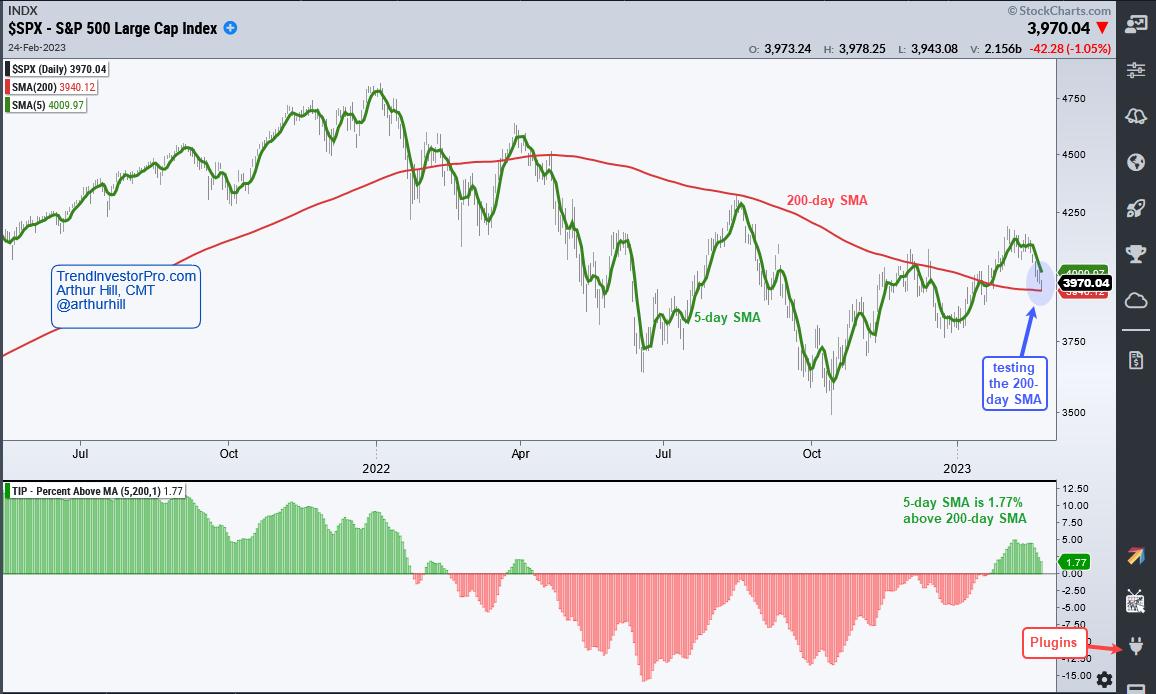The stock market has been a tough place for trend-following since January 2022, which is when the S&P 500 first triggered a bearish trend signal. The bearish signal in question is the humble 5/200 day SMA cross. There were whipsaws in the first quarter of 2022 and then an extended downtrend from April 11th until January 23rd. The 5-day SMA crossed above the 200-day SMA on January 24th and this cross remains bullish until proven otherwise. Despite whipsaws in 2022, this moving average cross warrants our attention because a bearish cross could foreshadow a move to new lows.
The chart below shows the S&P 500 with the 5-day SMA and 200-day SMA. The indicator window shows Percent Above MA (5, 200, 0), which is part of the TIP Indicator Edge plugin. This indicator shows the percentage difference between the 5 and 200 day SMAs. Currently, the 5-day is 1.77% above the 200-day. A cross below zero would signal a bearish moving average cross.
Prior signals resulted in whipsaws so why should we respect this cross? Whipsaws are part of the process for trend-following indicators. We can reduce the whipsaws by smoothing the close with a 5-day SMA, but we cannot totally illuminate them. Traders looking to catch big trends must learn to live with the whipsaws. It is the cost of doing business for trend-followers. We have to take the signal to catch the trends. Let’s crunch some numbers.
A simple trend following indicator can help us maintain returns and greatly reduce drawdowns. The table below shows performance metrics for buy-and-hold, the close/200-day cross and the 5/200 day cross. Over the last 20 years, buying and selling 5/200 cross signals worked 47% of the time (Win%) and the Compound Annual Return (CAR) was 6.71%. The average of the 5 largest drawdowns was 16%. Buy-and-hold had a higher Compound Annual Return (CAR), but the average drawdown was almost twice that of the 5/200 cross. Buy-and-hold went through a 55% drawdown in February 2009 and a 33% drawdown in March 2020.
This is as simple as it gets for trend-following and determining the direction of the most important benchmark for the US stock market. The S&P 500 is the most widely followed index, it is the most used index for benchmarking returns and the 200-day SMA is the most widely used long-term moving average. The state of the S&P 500 is also something to consider when trading stocks and ETFs. In general, I want to be long stocks when the S&P 500 is in an uptrend and out when the S&P 500 is in a downtrend. Even though there is chance of a whipsaw, a 5/200 cross would be bearish and I would respect this signal.
TrendInvestorPro is currently working with three quantified strategies for trading ETFs. We have a Bull-Bear Strategy trading the All Weather List, a Trend-Momentum Strategy Trading stock-related ETFs and a Mean-Reversion Strategy. Each strategy has a detailed article and signal tables are updated daily. Click here to learn more.
The Trend Composite, Momentum Composite, ATR Trailing Stop and eight other indicators are part of the TrendInvestorPro Indicator Edge Plugin for StockCharts ACP. Click here to learn more and take your analysis process to the next level.
—————————————
























